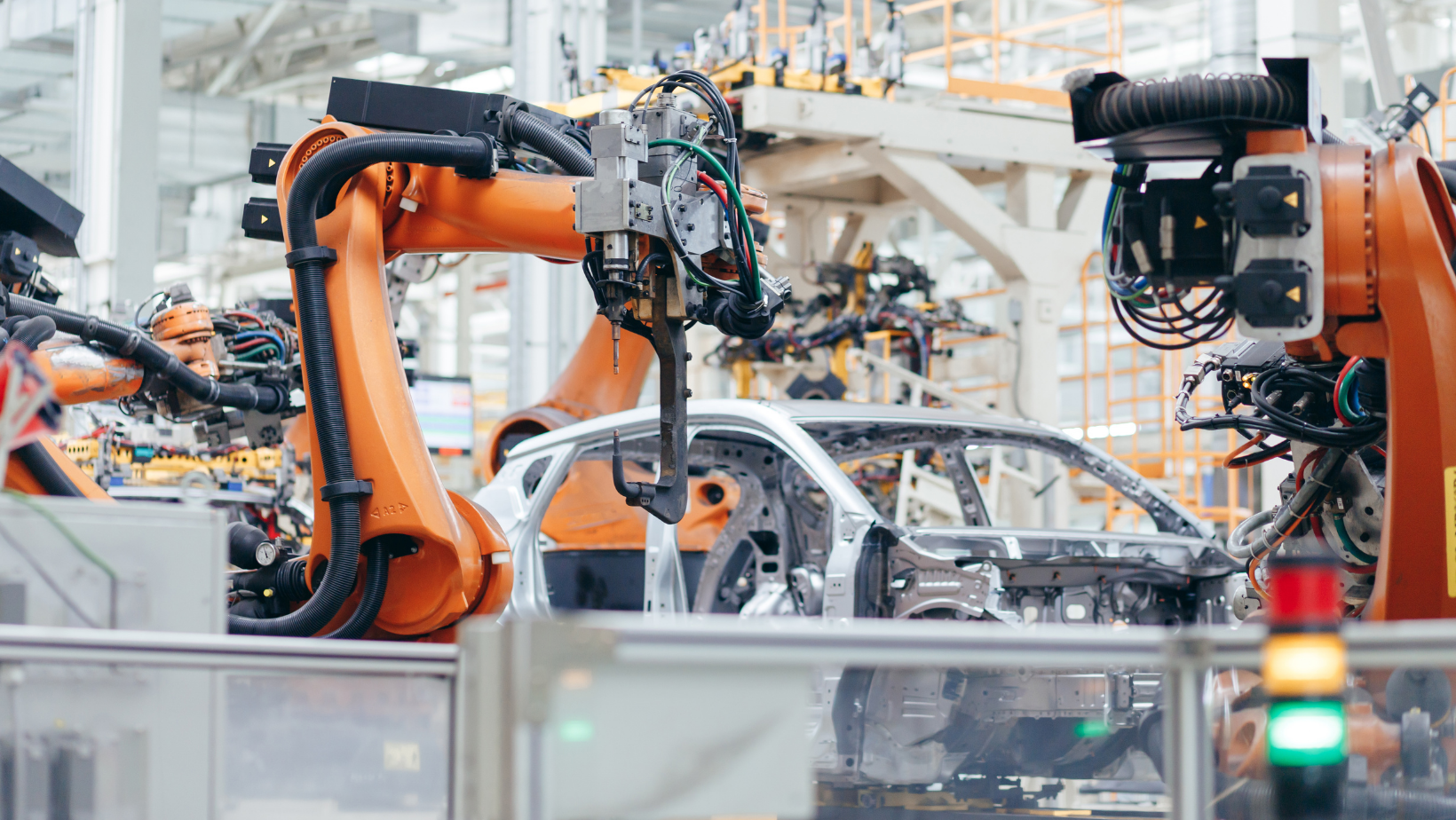AI in Automotive: Transforming the Automobile Industry

The automotive industry stands at a critical inflection point. As artificial intelligence reshapes manufacturing, supply chains, and customer experiences, automotive companies must adapt or risk obsolescence. The numbers tell a compelling story: the automotive AI market is projected to reach $35.71 billion by 2033, signaling not just incremental change but fundamental transformation.
At Blue Orange Digital, we’ve witnessed firsthand how automotive leaders leverage AI and data analytics to solve pressing operational challenges. From predictive maintenance systems that prevent costly breakdowns to intelligent supply chain optimization that reduces inventory costs by millions, the opportunities are both immediate and transformative.
The Current State of AI Adoption in Automotive
Today’s automotive landscape presents a paradox: while autonomous vehicles capture headlines, the real AI revolution happens behind the scenes in factories, dealerships, and corporate data centers. Manufacturing plants now deploy computer vision systems that detect defects invisible to the human eye. Service centers use predictive analytics to anticipate vehicle maintenance needs before problems occur.
Consider the shift in electric vehicle adoption. Despite market fluctuations, EV sales are expected to grow 16% by 2025, with AI playing a crucial role in battery optimization, charging infrastructure management, and grid integration. This isn’t speculation—it’s happening now in production facilities worldwide.
Transforming Manufacturing Operations with Intelligent Automation
Modern automotive manufacturing demands precision at scale. AI-powered quality control systems now process thousands of components per hour, identifying microscopic defects that would escape traditional inspection methods. But the real breakthrough comes from predictive intelligence.
Predictive Maintenance: From Reactive to Proactive
Manufacturing equipment generates massive volumes of sensor data every second. By implementing machine learning models on platforms like Databricks, manufacturers can predict equipment failures days or weeks in advance. One automotive supplier we worked with reduced unplanned downtime by 40% within six months of deploying predictive maintenance algorithms.
The key lies in data integration. Modern factories generate data from hundreds of sources—temperature sensors, vibration monitors, production line cameras, and quality control systems. Consolidating this data into a unified analytics platform like Snowflake enables real-time monitoring and predictive modeling at scale.
Supply Chain Intelligence
Global supply chains face unprecedented complexity. AI agents now monitor thousands of suppliers, tracking everything from raw material availability to geopolitical risks. These systems don’t just react to disruptions—they anticipate them.
For instance, natural language processing algorithms scan news feeds, weather reports, and shipping data to identify potential supply chain bottlenecks before they impact production. When a typhoon threatens a critical supplier in Southeast Asia, AI systems automatically trigger contingency plans, rerouting orders and adjusting production schedules.
Revolutionizing the Customer Journey
The automotive customer experience extends far beyond the showroom. McKinsey reports that online car sales could reach $754 billion by 2025, driven by AI-powered personalization and virtual shopping experiences.
Intelligent Customer Analytics
Modern dealerships sit on goldmines of customer data—service records, purchase histories, website interactions, and social media engagement. AI transforms this raw data into actionable insights. Machine learning models predict when customers are likely to purchase their next vehicle, what features matter most to them, and which financing options align with their preferences.
Blue Orange Digital recently helped a major dealership network implement customer lifetime value modeling. By analyzing historical transaction data and behavioral patterns, we identified high-value customer segments and optimized marketing spend, resulting in a 25% increase in customer retention rates.
Service Center Optimization
AI revolutionizes vehicle servicing through intelligent diagnostics and scheduling. Connected vehicles stream diagnostic data directly to service centers, where AI algorithms analyze error codes, sensor readings, and historical repair data to diagnose issues before the customer even arrives.
This proactive approach transforms the service experience. Instead of waiting hours for diagnosis, customers receive accurate repair estimates and scheduling options before they reach the service center. Parts can be pre-ordered, technicians pre-assigned, and repair times dramatically reduced.
Data Architecture: The Foundation of Automotive AI
Success in automotive AI requires robust data infrastructure. Legacy systems, siloed databases, and incompatible formats create barriers to innovation. Modern data platforms solve these challenges through unified architectures that support real-time analytics and machine learning at scale.
Building a Modern Data Stack
Automotive companies generate petabytes of data across multiple domains:
- Vehicle telemetry: Real-time sensor data from millions of connected vehicles
- Manufacturing data: Production metrics, quality control measurements, equipment sensors
- Customer data: Sales records, service histories, digital interactions
- Supply chain data: Inventory levels, supplier performance, logistics tracking
Integrating these diverse data sources requires sophisticated data engineering. Cloud-native platforms like Snowflake provide the scalability and flexibility needed to handle automotive data volumes, while tools like Databricks enable advanced analytics and machine learning workflows.
Practical AI Implementation Strategies
While the potential of automotive AI is immense, successful implementation requires strategic planning and phased execution. Based on our experience with automotive clients, we recommend a structured approach:
Start with High-Impact Use Cases
Focus initial AI investments on areas with clear ROI. Predictive maintenance in manufacturing, inventory optimization in parts distribution, and lead scoring in sales typically deliver quick wins that build momentum for broader transformation.
Invest in Data Quality
AI models are only as good as their training data. Establishing data governance frameworks, implementing quality monitoring, and creating feedback loops ensure AI systems improve over time rather than degrading.
Build Cross-Functional Teams
Successful AI initiatives require collaboration between domain experts and data scientists. Mechanics understand vehicle systems; data scientists understand algorithms. Combining these perspectives creates solutions that are both technically sophisticated and practically applicable.
Measuring Success: Key Performance Indicators
Tracking AI impact requires carefully selected metrics aligned with business objectives:
| Business Area | AI Application | Key Metrics |
|---|---|---|
| Manufacturing | Predictive Maintenance | Downtime reduction, maintenance cost savings, equipment lifespan extension |
| Quality Control | Computer Vision Inspection | Defect detection rate, false positive reduction, inspection throughput |
| Supply Chain | Demand Forecasting | Forecast accuracy, inventory turns, stockout frequency |
| Sales | Lead Scoring | Conversion rate improvement, sales cycle reduction, customer acquisition cost |
| Service | Predictive Diagnostics | First-time fix rate, diagnostic accuracy, customer satisfaction scores |
Overcoming Implementation Challenges
Despite clear benefits, automotive companies face significant hurdles in AI adoption. Legacy systems resist integration with modern platforms. Skilled data scientists remain scarce. Organizational inertia slows transformation efforts.
Technical Debt and Legacy Systems
Many automotive companies operate systems decades old. These legacy platforms weren’t designed for real-time data processing or machine learning workloads. Modernization requires careful planning to maintain operational continuity while building new capabilities.
Cloud migration strategies offer a path forward. By gradually moving workloads to cloud platforms, companies can modernize infrastructure without disrupting operations. Hybrid architectures allow critical systems to remain on-premises while new AI capabilities deploy in the cloud.
Talent and Skills Gap
The automotive industry competes with tech giants for AI talent. Building internal capabilities requires investment in training and development. Partnering with specialized firms like Blue Orange Digital provides immediate access to expertise while internal teams develop skills.
The Road Ahead: Future-Proofing Automotive Operations
The automotive industry’s AI transformation has only just begun. As vehicles become increasingly connected and autonomous, data volumes will explode. Companies that build robust data infrastructure and AI capabilities today will lead tomorrow’s market.
Success requires more than technology investment. Cultural transformation, strategic vision, and operational excellence combine to create sustainable competitive advantage. Organizations must embrace data-driven decision-making at every level, from the factory floor to the executive suite.
Emerging Technologies on the Horizon
Several technologies promise to accelerate automotive AI adoption:
- Edge computing: Processing data directly in vehicles reduces latency and enables real-time decision-making
- Digital twins: Virtual replicas of physical assets enable simulation and optimization without production disruption
- Federated learning: Training AI models across distributed datasets preserves privacy while improving performance
- Quantum computing: Next-generation processors could solve complex optimization problems currently beyond reach
Taking Action: Your AI Transformation Journey
The question isn’t whether to adopt AI in automotive operations—it’s how quickly you can move without compromising quality or safety. Every day of delay represents lost efficiency, missed opportunities, and competitive disadvantage.
Start by assessing your current data maturity. Identify high-value use cases that align with business priorities. Build proof-of-concept projects that demonstrate tangible value. Scale successful initiatives across the organization.
Blue Orange Digital specializes in helping automotive companies navigate this transformation. Our expertise in data engineering, AI implementation, and change management accelerates time-to-value while minimizing risk. We’ve helped manufacturers reduce defects, dealers increase sales, and service centers improve customer satisfaction—all through strategic AI deployment.
The automotive industry’s future belongs to companies that harness AI’s power today. Whether optimizing manufacturing processes, enhancing customer experiences, or revolutionizing vehicle design, AI provides the tools for transformation. The journey requires commitment, investment, and expertise—but the destination promises unprecedented efficiency, innovation, and growth.


